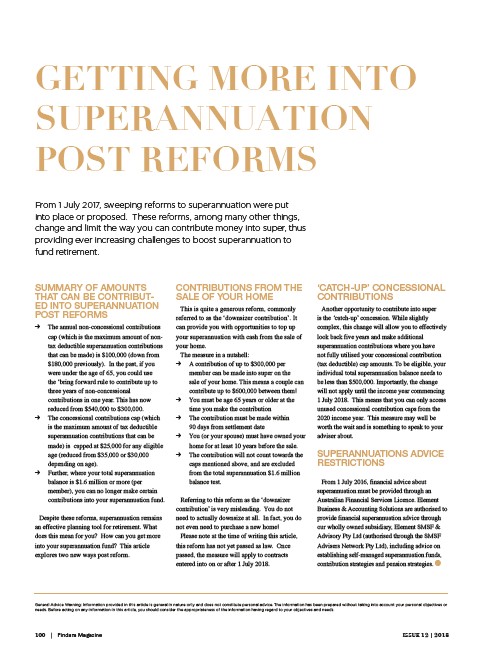
GETTING MORE INTO
SUPERANNUATION
POST REFORMS
From 1 July 2017, sweeping reforms to superannuation were put
into place or proposed. These reforms, among many other things,
change and limit the way you can contribute money into super, thus
providing ever increasing challenges to boost superannuation to
fund retirement.
SUMMARY OF AMOUNTS
THAT CAN BE CONTRIBUT-ED
INTO SUPERANNUATION
POST REFORMS
The annual non-concessional contributions
cap (which is the maximum amount of non-
tax deductible superannuation contributions
that can be made) is $100,000 (down from
$180,000 previously). In the past, if you
were under the age of 65, you could use
the ‘bring forward rule to contribute up to
three years of non-concessional
contributions in one year. This has now
reduced from $540,000 to $300,000.
The concessional contributions cap (which
is the maximum amount of tax deductible
superannuation contributions that can be
made) is capped at $25,000 for any eligible
age (reduced from $35,000 or $30,000
depending on age).
Further, where your total superannuation
balance is $1.6 million or more (per
member), you can no longer make certain
contributions into your superannuation fund.
Despite these reforms, superannuation remains
an effective planning tool for retirement. What
does this mean for you? How can you get more
into your superannuation fund? This article
explores two new ways post reform.
CONTRIBUTIONS FROM THE
SALE OF YOUR HOME
This is quite a generous reform, commonly
referred to as the ‘downsizer contribution’. It
can provide you with opportunities to top up
your superannuation with cash from the sale of
your home.
The measure in a nutshell:
A contribution of up to $300,000 per
member can be made into super on the
sale of your home. This means a couple can
contribute up to $600,000 between them!
You must be age 65 years or older at the
time you make the contribution
The contribution must be made within
90 days from settlement date
You (or your spouse) must have owned your
home for at least 10 years before the sale.
The contribution will not count towards the
caps mentioned above, and are excluded
from the total superannuation $1.6 million
balance test.
Referring to this reform as the ‘downsizer
contribution’ is very misleading. You do not
need to actually downsize at all. In fact, you do
not even need to purchase a new home!
Please note at the time of writing this article,
this reform has not yet passed as law. Once
passed, the measure will apply to contracts
entered into on or after 1 July 2018.
‘CATCH-UP’ CONCESSIONAL
CONTRIBUTIONS
Another opportunity to contribute into super
is the ‘catch-up’ concession. While slightly
complex, this change will allow you to effectively
look back five years and make additional
superannuation contributions where you have
not fully utilised your concessional contribution
(tax deductible) cap amounts. To be eligible, your
individual total superannuation balance needs to
be less than $500,000. Importantly, the change
will not apply until the income year commencing
1 July 2018. This means that you can only access
unused concessional contribution caps from the
2020 income year. This measure may well be
worth the wait and is something to speak to your
adviser about.
SUPERANNUATIONS ADVICE
RESTRICTIONS
From 1 July 2016, financial advice about
superannuation must be provided through an
Australian Financial Services Licence. Element
Business & Accounting Solutions are authorised to
provide financial superannuation advice through
our wholly owned subsidiary, Element SMSF &
Advisory Pty Ltd (authorised through the SMSF
Advisers Network Pty Ltd), including advice on
establishing self-managed superannuation funds,
contribution strategies and pension strategies.
General Advice Warning: Information provided in this article is general in nature only and does not constitute personal advice. The information has been prepared without taking into account your personal objectives or
needs. Before acting on any information in this article, you should consider the appropriateness of the information having regard to your objectives and needs.
100 | Pindara Magazine ISSUE 12 | 2018